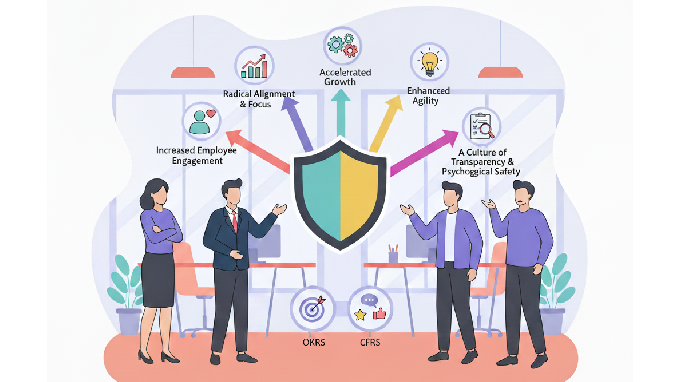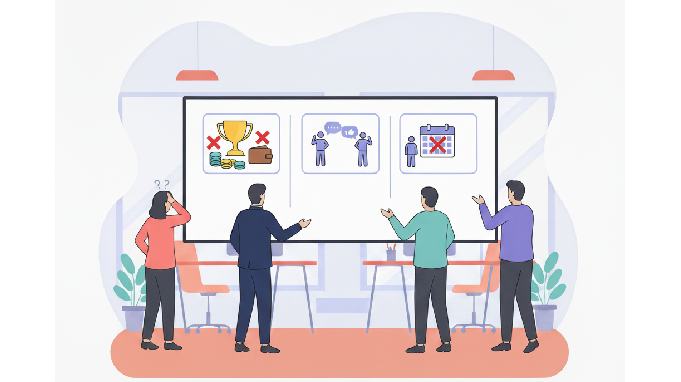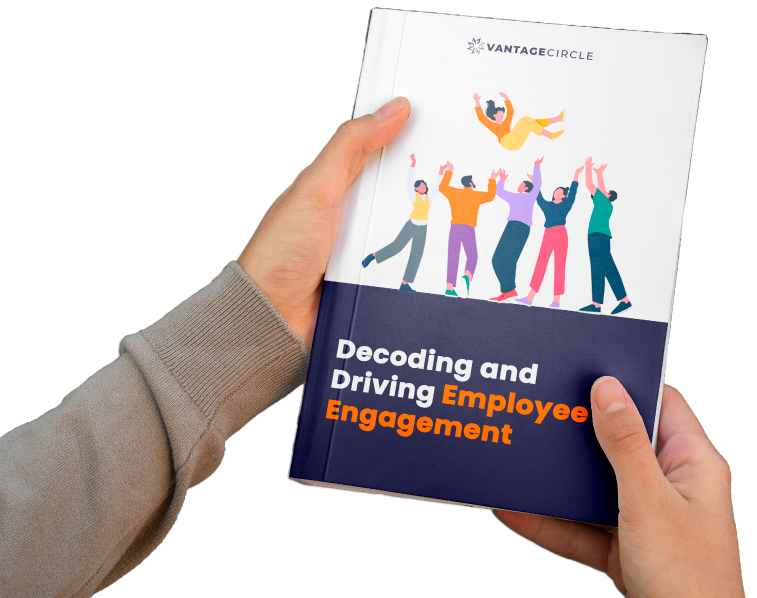How Can You Combine OKRs and CFRs to Build a High-Performance Team?

A Global Employee Recognition and Wellness Platform
Are your company's ambitious goals dwindling by the end of the quarter? And your teams feel disconnected from the big picture?
Well, it’s a common problem where companies set bold OKRs only to see them lose momentum.
However, the secret to ensuring these goals actually drive results lies in combining OKRs with CFRs.
Continuing in the same vein, legendary venture capitalist John Doerr, in his New York Times Bestseller Measure What Matters, reveals how the OKR system has fueled the success of tech giants like Google and Intel, driving explosive growth.
He also introduced the concept of CFRs as the necessary partner to OKRs, underscoring that without Conversations, Feedback, and Recognition, even the best goals can lose their impact.
In this article, I’ll show you how to seamlessly integrate these two powerful frameworks. You are in store for setting impactful goals and simultaneously creating continuous engagement that turns them into real success.
What are OKRs and CFRs?
What is the OKR (Objectives and Key Results) Framework?

OKRs are a goal-setting framework designed to add clarity and measurability to your team’s ambition.
Objectives define what we want to achieve. They are qualitative and inspirational goals aligned with the organization’s vision.
Having a strong objective excites your team and gives them a reason to care. They should be bold, inspiring, and aligned with the organization’s vision.
Key results define how we measure success. These are quantitative metrics that prove you've achieved your objective. They're specific, measurable, verifiable, and track progress toward the objective.
Example:
Let’s say my Marketing team’s objective is to “Increase brand visibility in North America.”
Our Key Results might include:
- Achieve a 30% increase in website traffic from the U.S.
- Secure 15 media mentions in top HR publications.
- Grow LinkedIn followers by 20%.
This structure ensures everyone knows exactly where we’re heading and how progress is measured.
According to an OKR Impact Report, 83% of companies working with OKRs believe they have benefited from implementing the framework.
What is the CFR (Conversations, Feedback, Recognition) System?

If OKRs comprise the “what and how,” giving structure to performance, CFRs are the heart and soul of performance. You can craft the best OKRs, but without the human element, they fall short. This is where CFRs come in, breathing life into your OKRs.
Conversations: These are structured, two-way dialogues about progress, priorities, and personal growth. Don’t confuse them with painful annual reviews.
They are authentic, regular check-ins to discuss progress on OKRs, identify obstacles, and explore career development. They're collaborative, not evaluative.
Feedback: These are constructive, multidirectional inputs that help individuals learn, adapt, and improve. In a CFR environment, feedback flows in all directions: manager-to-employee, employee-to-manager, and peer-to-peer.
It's timely, specific, and focused on helping people improve continuously rather than waiting for a formal review cycle.
Recognition: It is a genuine appreciation for contributions that reinforce desired behaviors and culture.
These are not confined to generic "good job" emails. They are specific, meaningful acknowledgments of contributions, both big and small, that reinforce the behaviors and results to drive your OKRs forward.
According to a study, well-recognized employees are 7 times more likely to be fully engaged compared to those who are not recognized.
What is the Difference between OKRs and CFRs?
| Aspect | OKRs (Objectives and Key Results) | CFRs (Conversations, Feedback, Recognition) |
|---|---|---|
| Primary Purpose | Define what needs to be achieved and how to measure success. | Define how teams collaborate and communicate to achieve those goals. |
| Focus | Goal-setting and strategic alignment. | People development and performance enablement. |
| Nature | Outcome-oriented and measurable. | Process-oriented and relational. |
| Frequency | Quarterly cycles (with weekly progress checks) | Continuous and ongoing (weekly/monthly touchpoints) |
| Structure | Quantitative metrics and targets. | Qualitative dialogues and interactions. |
| Drives | Clarity, focus, and alignment on priorities. | Engagement, agility, and psychological safety. |
| Answers | "Where are we going?" and "Are we there yet?" | "How are we doing?" and "What support do you need?" |
| Risks if Used Alone | Becomes sterile, transactional, and ignored after initial setup. | Lacks direction and measurable impact without clear goals. |
Aspect:Primary Purpose
OKRs (Objectives and Key Results) : Define what needs to be achieved and how to measure success.
CFRs (Conversations, Feedback, Recognition) : Define how teams collaborate and communicate to achieve those goals.
Aspect: Focus
OKRs (Objectives and Key Results):Goal-setting and strategic alignment.
CFRs (Conversations, Feedback, Recognition) : People development and performance enablement.
Aspect: Nature
OKRs (Objectives and Key Results):Outcome-oriented and measurable.
CFRs (Conversations, Feedback, Recognition) : Process-oriented and relational.
Aspect: Frequency
OKRs (Objectives and Key Results): Quarterly cycles (with weekly progress checks)
CFRs (Conversations, Feedback, Recognition) : Continuous and ongoing (weekly/monthly touchpoints)
Aspect: Structure
OKRs (Objectives and Key Results) : Quantitative metrics and targets.
CFRs (Conversations, Feedback, Recognition) : Qualitative dialogues and interactions.
Aspect: Drives
OKRs (Objectives and Key Results) : Clarity, focus, and alignment on priorities.
CFRs (Conversations, Feedback, Recognition) : Engagement, agility, and psychological safety
Aspect: Answers
OKRs (Objectives and Key Results): "Where are we going?" and "Are we there yet?"
CFRs (Conversations, Feedback, Recognition) : "How are we doing?" and "What support do you need?"
Aspect: Risks if Used Alone
OKRs (Objectives and Key Results): Becomes sterile, transactional, and ignored after initial setup.
CFRs (Conversations, Feedback, Recognition) : Lacks direction and measurable impact without clear goals.
Why Do OKRs and CFRs Work So Powerfully Together?
If you’re planning to implement OKRs without CFRs, let me be clear that you are heading for disappointment.
There have been several cases where companies have invested in expensive OKR software, held elaborate goal-setting sessions, and then kept wondering why nothing changed.
Here’s why these two frameworks are powerful together:
Giving Goals a Human Voice
Without CFRs, OKRs are nothing but just a bunch of cold metrics on a spreadsheet, stripped of the human effort behind them. In fact, CFRs inject empathy and dialogue into those numbers.
They help leaders coach rather than command, ensuring that every employee understands “why” their goals matter, not just “what” they are.
The context and motivation that CFRs provide establish a sense of connection among employees towards the purpose of their OKRs.
This, in turn, unleashes their energy and creativity to achieve them.
From Annual Reviews to Continuous Performance Management
Let’s be vocal. Annual reviews have lost their essence and are obsolete. The rigid and retrospective system is more anxiety-inducing.
The combination of OKRs and CFRs brings a fresh essence to reviews and performance management by replacing the once-a-year judgment.
Instead of one high-stakes conversation per year, you’ll be having:
- Weekly team check-ins to discuss OKR progress
- Monthly one-on-ones to provide feedback and recognition
- Real-time course corrections when things aren't working
- Continuous recognition when people do exceptional work
While OKRs set the target, CFRs create the necessary dialogue that keeps progress alive. The continuous rhythm of the two keeps performance management agile, developmental, and far more human.
The Top 5 Benefits of Combining OKRs and CFRs

A combination of OKRs and CFRs can benefit organizations in several ways. Let’s explore them below:
A combination of OKRs and CFRs can benefit organizations in several ways. Let’s explore them below:
1. Radical Alignment & Focus:
OKRs ensure everyone is moving in the same direction and that employees understand how their work contributes to the bigger picture. However, this alignment is not a one-time event; it requires constant reinforcement.
This is where CFRs come into the picture. Through regular conversations, you can keep your teams focused and grounded in the daily priorities that drive those results.
2. Increased Employee Engagement:
The OKR framework demonstrates that employees’ work matters by showing a direct connection between their efforts and the company’s success.
The CFR system shows employees that they matter. This is reflected through regular conversations, meaningful feedback, and genuine recognition.
The sense of value and support that employees receive through this combination undoubtedly boosts employee engagement.
3. Enhanced Agility:
OKRs set clear, committed goals for the quarter, ensuring that your objectives remain consistent and are not swayed by minor, new observations.
CFRs give you the flexibility to be agile in how you achieve these goals. Basically, the frequent feedback loops allow teams to identify roadblocks early and pivot quickly.
4. A Culture of Transparency & Psychological Safety:
When OKRs are transparent, that layer of mystery and politics is removed from performance. And when we tune in to CFRs, we create space for honest conversations about challenges and failures.
The space created for openness by making employees feel safe and comfortable sharing their opinions is where trust begins to build and becomes the norm.
Research shows that in organizations with psychological safety, 75% of employees report feeling more confident to share ideas
5. Accelerated Growth & 10X Results: The Compound Effect of Excellence
When you combine all the benefits discussed above, alignment, engagement, agility, and psychological safety, there is only room for exponential growth.
The benefits when reflected in your data will speak for themselves.
How Do You Implement OKRs and CFRs Step-by-Step
Since you have understood why the combination is powerful, it is time to walk through the practical roadmap for implementation.
This section is utterly essential, given how many initiatives fail due to execution issues.
Step 1: Set Clear and Ambitious OKRs
Start the process by defining 2–4 objectives per team and 2–4 key results per objective.
Ensure that they are ambitious yet realistic and achievable. It should be enough to inspire and not intimidate.
Here’s a detailed guide to setting OKRS: OKRs for Employee Engagement: A Powerful Tool (With Examples)
Step 2: Integrate CFRs into Your Weekly Rhythm
Make sure to integrate CFRs into your regular rhythm from day one. For that, schedule weekly team check-ins and monthly 1-on-1s.
These sessions turn OKRs from static documents into living and breathing priorities.
Here’s a sample weekly check-in agenda to abide by:
- Review OKR progress (data-driven snapshot).
- Discuss challenges and blockers.
- Share feedback across the team.
- Recognize contributions or breakthroughs.
- Set next week’s focus points.
Step 3: Master Each Component of CFRs
Conversations: The Questions That Unlock Performance
The quality of your conversations is determined by the quality of the questions you ask your employees. Hence, opt for powerful questions in one-on-ones:
About OKR Progress:
- "On a scale of 1-10, how confident are you in achieving this key result? What would move you up one point?"
- "What's the biggest roadblock preventing you from making faster progress?"
- "If you remove one obstacle, what would it be?"
- "What's one thing going better than expected? What's driving that success?"
About Support and Development:
- "What support do you need from me that you're not getting?"
- "What skill would you like to develop this quarter that would help you achieve these OKRs?"
- "Who else on the team should you be collaborating with more closely?"
- "What am I doing that's helpful? What should I stop doing?"
About Career and Motivation:
- "How does this OKR connect to your longer-term career goals?"
- "What aspect of this work energizes you most? What drains you?"
- "What would make this quarter feel like a huge win for you personally?"
The key is to ask, listen genuinely, and take action following the conversation. Conversations without follow-ups destroy trust faster than no conversations at all.
Feedback:
There are four non-negotiable rules to deliver effective feedback.
Rule 1: Be Specific
- Bad: "Your presentation wasn't great."
- Good: "In your presentation, the data on slide 7 contradicted the conclusion on slide 9, which confused the executive team. Let's review the analysis together."
Rule 2: Be Timely
Give feedback within 24-48 hours of the event, while it's still fresh and actionable. Waiting until a formal review is too late.
According to research, 43% of highly engaged employees receive feedback at least once a week, compared to 18% of employees with low engagement.
Rule 3: Be Action-Oriented
Every piece of feedback should include what success looks like going forward.
- Bad: "You need to communicate better."
- Good: "For complex projects, send a brief weekly update email to stakeholders outlining progress, risks, and decisions needed. This will prevent the miscommunication we experienced last week."
Rule 4: Make it Bi-Directional
- I always ask for feedback after I give it: "What feedback do you have for me on how I'm supporting you?"
- This model's vulnerability and reinforces that feedback is about growth, not hierarchy.
Recognition:
This is one critical aspect where organizations still fall flat. They either don’t recognize enough or recognize in ways that feel hollow and meaningless.
So, here’s the category of recognition organizations should stick to:
Public Recognition:
- Celebrate wins in team meetings, company-wide channels, or all-hands meetings
- The visibility amplifies the impact and reinforces the behaviors you want to see
Specific Recognition:
- Bad: "Great job this quarter, Sarah!"
- Good: "Sarah, your analysis of the customer churn data directly led to us adjusting our onboarding process, which contributed to us achieving our retention key result. Your thoroughness made the difference."
**Peer-to-Peer Recognition:
- Don't make recognition only flow from managers. Build systems that allow peers to recognize each other.
Gartner reports that peer recognition can improve workplace performance by 14%.
- Use dedicated platforms like Vantage Recognition, which make recognition swift and hassle-free, flowing across directions, thus weaving appreciation into the daily workflow.

Source: Vantage Recognition and Rewards
Step 4: Review, Reflect, and Reset
At the end of every quarter, conduct a “Review, Reflect, and Reset” session, where you close the loop on OKRs using CFR principles. Here’s how you can proceed with the session:
Results Review:
- What did we achieve? (Measure each key result objectively)
- What did we learn? (What worked, what didn't)
- Recognize exceptional contributions
Reflection:
- Where did we exceed expectations? What drove that success?
- Where did we fall short? What were the root causes?
- How effective were our conversations, feedback, and recognition?
Feedback Exchange:
- Team members share feedback on the OKR process itself
- Manager shares observations on team dynamics and execution
- Identify improvements for next quarter
Reset:
- Set OKRs for the next quarter
- Commit to CFR cadence adjustments based on feedback
- Celebrate the quarter and energize for what's next
This quarterly rhythm ensures that OKRs don't become stale, and that CFRs continuously evolve based on what's working.
What Common Mistakes Will Derail Your OKR and CFR Implementation

These mistakes can contradict the very essence for which you have implemented OKR and CFR for. Be careful not to fall for these mistakes and avoid them at any cost.
Mistake 1: Tying OKR Achievement Directly to Compensation
The biggest mistake is to link OKRs directly to bonuses. The moment you do this, ambition among employees will die. Employees will be driven to set safe goals to guarantee payouts.
You will end up creating an incentive system that encourages underperformance, which goes against the very purpose of OKRs.
Let me be clear: OKRs are for alignment, focus, and growth, and not for calculating bonuses. They're designed to stretch your team toward ambitious outcomes, and that means accepting that 70-80% achievement is excellent performance.
While CFR-driven performance discussions can inform compensation, there should never be a one-to-one formula.
Mistake 2: Forgetting the “F” and “R” in CFRs
This often happens when teams implement OKRs and have weekly conversations, but entirely neglect Feedback and Recognition.
As a result, the weekly check-ins start feeling like interrogations or status reports, more like micromanagement. There’s no constructive guidance, and nobody feels appreciated. Feedback without empathy frustrates; recognition without sincerity feels hollow.
If you're only doing conversations without feedback and recognition, you're building a surveillance culture, not a high-performance culture. People feel micromanaged rather than supported.
Hence, we need both ‘F’ and ‘R’ for CFRs to work. They are human elements that make conversations effective.
Mistake 3: Setting and Forgetting OKRs
Here's the brutal truth: The most significant reason OKRs fail is the absence of CFRs.
It is so common that companies invest weeks in crafting perfect OKRs, but after a kickoff meeting, there is nothing but silence.
Without ongoing CFRs, teams lose sight of goals by week two.
The main problem is that OKRs don’t fail, but you failed to implement CFRs.
Without constant conversations, feedback, and recognition, OKRs become useless.
Think about it: If you set fitness goals on January 1st but never check your progress, never get coaching, and never celebrate milestones, would you achieve those goals? Of course not. Yet this is exactly what companies do with OKRs.
In a nutshell, consistency is key; it’s the rhythm of CFRs that keeps OKRs relevant.
Conclusion
A deep dive into this article has definitely given you clarity on OKRs and CFRs, and more importantly, on how their combination can be a game-changer for organizations seeking to set impactful goals and achieve them.
It’s time you implemented these frameworks in your organization and gave your organizational processes a proper structure.
Frequently Asked Questions
What is the main difference between OKRs and CFRs?
OKR is a goal-setting framework focused on strategic alignment. CFR is a communication and continuous performance management system focused on human interaction.
Can you do OKRs without CFRs?
You can, but it's highly likely to fail. Without CFRs, OKRs become a "set and forget" exercise that lacks the engagement and real-time adjustments needed for success.
How often should CFR conversations happen?
A good cadence is weekly team check-ins for progress updates and monthly or bi-weekly 1-on-1s for deeper, development-focused conversations.
How do you adapt OKRs and CFRs for a hybrid or remote team?
Use digital platforms to track OKRs and hold regular video check-ins for CFRs, ensuring continuous feedback and recognition. Leverage asynchronous communication tools to maintain engagement and alignment across time zones.
















